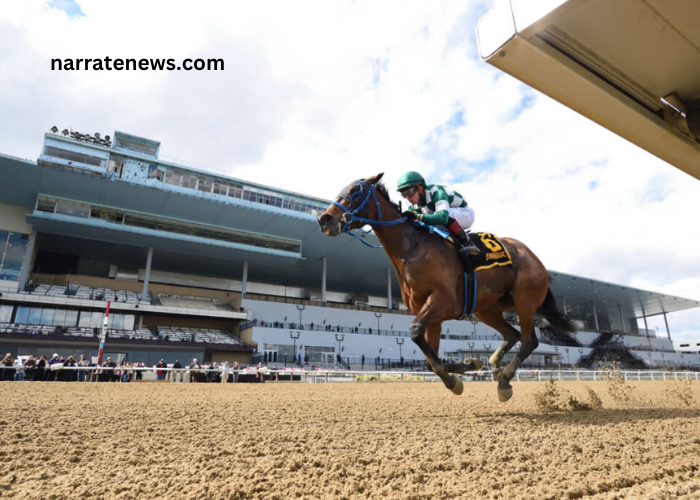
Unraveling the Rich Tapestry of Aqueduct Horse Racing
Nestled in the heart of Queens, New York, Aqueduct Racetrack stands as a monument to the grandeur and excitement of thoroughbred horse racing. Steeped in history and tradition, Aqueduct has been a hallowed ground for racing enthusiasts, showcasing the finest horses, jockeys, and trainers in the sport. In this comprehensive article, we will explore the multifaceted world of Aqueduct horse racing, from its storied origins to the thrill of race day, while delving into the key aspects that make it a cornerstone of the racing world.
Aqueduct Horse Racing
Origins and History
Aqueduct Racetrack has a lineage that traces back to the early 20th century. Opened on September 27, 1894, by the Queens County Jockey Club, it initially operated as the Queens County Racetrack. The track underwent several transformations and relocations before finding its permanent home in Ozone Park, Queens, in 1959.
The name “Aqueduct” was inspired by the nearby conduit that supplied fresh water to New York City, reflecting the symbiotic relationship between the urban landscape and this equestrian haven. Over the years, Aqueduct has evolved, witnessed historic moments, and solidified its status as a premier racing venue on the East Coast.
Aqueduct Racetrack Today
Aqueduct Racetrack, commonly referred to as “The Big A,” hosts racing meets during the fall and winter months. Known for its distinctive inner dirt track and outer turf track, the facility offers a diverse range of racing experiences. The inner dirt track, in particular, is notable for hosting the iconic Aqueduct winter meet, attracting top-class horses competing in high-stakes races.
The racetrack is a hub of activity, not just for racing enthusiasts but also for the broader community. Beyond the adrenaline-pumping races, Aqueduct offers an array of amenities, including dining options, entertainment, and a vibrant atmosphere that encapsulates the spirit of thoroughbred racing.
The Racing Season and Key Events
Aqueduct Racetrack operates primarily during the fall and winter months, with its racing season typically spanning from November to April. The winter meet, characterized by its inner dirt track, is renowned for hosting a series of prestigious races that captivate both casual fans and seasoned enthusiasts.
Among the marquee events at Aqueduct is the Cigar Mile Handicap, a Grade 1 race that attracts top-notch horses vying for glory. The race, named after the legendary Cigar, is a fitting climax to the Aqueduct fall meet, showcasing the speed, stamina, and skill of the competing thoroughbreds.
In addition to the Cigar Mile Handicap, Aqueduct features other significant races, including the Wood Memorial Stakes, a crucial prep race on the road to the Kentucky Derby. The Wood Memorial has produced illustrious winners who went on to achieve greatness on the national racing stage.
The Inner Dirt Track: A Unique Racing Experience
One of the distinctive features of Aqueduct Racetrack is its inner dirt track, which takes center stage during the winter months. The inner track provides a different racing experience compared to traditional dirt or turf surfaces. The challenging nature of the inner dirt track adds an extra layer of complexity, testing the mettle of both horses and jockeys.
Races on the inner dirt track often require a unique set of skills, as horses navigate the tighter turns and variable surface conditions. The winter meet at Aqueduct, characterized by the inner dirt track, has become synonymous with gritty performances and unpredictable outcomes, adding an element of intrigue for fans and bettors alike.
The People Behind the Scenes: Trainers, Jockeys, and Owners
At the heart of Aqueduct horse racing are the individuals who dedicate their lives to the sport – the trainers, jockeys, and owners. The racetrack serves as a stage for their talent, skill, and unwavering passion for thoroughbred racing.
- Trainers: The trainers play a pivotal role in preparing and conditioning horses for the challenges of Aqueduct’s tracks. Their expertise and strategic acumen are evident in the performance of the horses under their care. From devising training regimens to making race-day decisions, trainers are instrumental in the success of a racing stable.
- Jockeys: Jockeys are the daring athletes who guide the horses through the twists and turns of the racetrack. Their ability to form a seamless partnership with the horse, coupled with tactical race-riding skills, often determines the outcome of a race. Aqueduct has been graced by the presence of legendary jockeys whose careers are etched in the annals of racing history.
- Owners: Behind every horse on the Aqueduct track is an owner whose vision and commitment drive the pursuit of excellence. Owners invest not only financially but also emotionally in the sport, with dreams of seeing their thoroughbreds reach the winner’s circle. The bond between owners and their horses is a narrative that unfolds with each race at Aqueduct.
The Betting Experience: Wagering and Handicapping
Aqueduct Racetrack provides a thrilling experience for those who engage in the time-honored tradition of wagering on horse races. From novice bettors to seasoned handicappers, the racetrack offers a variety of betting options, including win, place, show, exacta, trifecta, and more.
Handicapping, the art of analyzing and predicting race outcomes, adds a strategic dimension to the spectator experience. Factors such as a horse’s past performances, jockey statistics, track conditions, and trainer patterns all come into play when making informed betting decisions. Aqueduct’s unique inner dirt track and the diverse field of competitors make handicapping an intriguing challenge for enthusiasts seeking to test their racing acumen.
Challenges and Controversies
While Aqueduct Racetrack has been a beacon of excitement and excellence, it has not been without its share of challenges and controversies. Issues such as track safety, the welfare of racehorses, and industry-wide concerns have prompted discussions and initiatives aimed at ensuring the well-being of both human and equine participants.
Track safety, in particular, has been a focal point, with advancements in technology and racetrack maintenance aimed at minimizing the risk of injuries to horses and riders. The racing industry as a whole continues to grapple with the balance between tradition and the evolving expectations regarding the ethical treatment of racehorses.
The Future of Aqueduct Racetrack
As Aqueduct Racetrack continues to evolve, questions about its future loom large. The racing landscape is dynamic, with the industry adapting to societal changes, technological advancements, and shifting preferences among spectators. Discussions about facility upgrades, the integration of modern amenities, and the potential for year-round racing are part of ongoing dialogues that will shape the next chapter of Aqueduct’s storied history.
Despite the challenges, Aqueduct remains a symbol of endurance and passion for horse racing. Its hallowed grounds echo with the hoofbeats of champions, the cheers of the crowd, and the timeless allure of a sport that transcends generations.
Conclusion
In the grand tapestry of American horse racing, Aqueduct Racetrack stands as a vibrant thread, weaving together tradition, excellence, and excitement. From its humble beginnings to the pageantry of marquee events, Aqueduct has etched its place in the hearts of racing enthusiasts.
As we immerse ourselves in the world of Aqueduct horse racing, we witness the convergence of history and innovation, competition and camaraderie. It is a realm where the thundering hooves on the track echo the spirit of a timeless pursuit—one that continues to capture the imagination of those who seek the thrill of the race, the elegance of the thoroughbred, and the enduring legacy of Aqueduct Racetrack.


